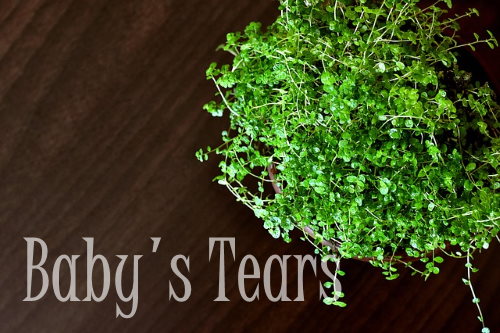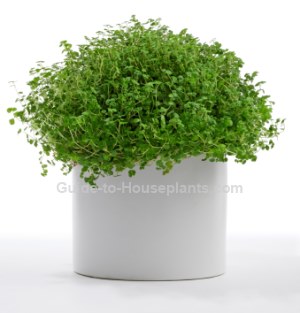How to Grow Baby's Tears Plant
Baby's Tears plant gets its name from the tiny, round leaves cascading down slender, fragile stems.
This beauty adds a lot of interesting texture to a group of plants, but it's better off in its own pot. Why? It needs frequent watering that's deadly to most houseplants. Besides, Baby's Tears will quickly take over a container, crowding other plants.
It is well-worth growing and easy to please, if you don't allow this lush plant to get thirsty. Discover how much sunlight it wants, when to repot, and why you'll need to trim it back.
 Growing in a thick mat of tiny leaves, this captivating plant loves moisture.
Growing in a thick mat of tiny leaves, this captivating plant loves moisture.Get to Know Baby's Tears Plant
It's known botanically as Soleirolia soleirolii. Other common names for this plant include: Mind-Your-Own-Business and Irish Moss.
This fast-growing evergreen has a low, spreading habit that spills beautifully over the sides of a container. It won't grow far though, because the creeping stems need to have contact with the soil.
Although this creeping plant seems well-suited for the moist environment of a terrarium, it is invasive and will crowd other plants. I'd recommend putting it in its own pot. Trim with scissors any time to keep it under control.
How big does it get? Up to 6 in (15 cm) tall, but will spread as far as it is allowed to go.
Does it bloom? Given enough light, Baby's Tears may produce tiny, single flowers in the leaf axils; however, they are barely noticeable. It typically blooms in summer.
Repot S. soleirolii in spring, when it outgrows its pot -- a wide, shallow pot will do. It makes a beautiful groundcover when planted under tall potted plants; however, it's a good idea to combine Baby's Tears with plants that prefer constant moisture.
If you just can't walk past a plant without fussing with it, this one is for you. Water it, mist it, and prune it to your heart's content.
Buying Tips
- Baby's Tears is formerly known as Helxine soleirolii and is still sometimes labeled by growers with that name.
- Don't be afraid to buy a small plant, this one grows fast.
- Some colorful varieties are available. 'Aurea' has golden-green foliage... 'Variegata' has silvery green variegated leaves.
Baby's Tears Plant Problems, Solutions and Answers
Brown, dry leaves may be caused by exposure to hot, direct sunlight. Or your plant dried out. Remember to keep the potting medium moist and raise the humidity around it.
Something bugging your houseplant? Watch for aphids that like to invade soft, new growth, which Soleirolia soleirolii has in abundance. Isolate any infested houseplant and treat it right away. Also watch for fungus gnats, that are attracted to wet, peaty potting mixes.
Is Baby's Tears poisonous? No, it's non-toxic to cats, dogs and people.

Baby's Tears Care Tips
Light: Will grow in low light, but prefers bright, indirect light. Keep out of direct sun, which will scorch the leaves.
Water: Keep the potting medium moist at all times. It will not tolerate dry soil.
Humidity: This plant thrives in high humidity. Aim to maintain at least 50% relative humidity around Baby's Tears plant. This is easier than it seems. Check out these easy tips for raising the humidity for house plants.
Temperature: Cool to average room temperatures 60-75°F/16-24°C
Soil: Any good potting mix; African violet potting mix works well to maintain moisture which this plant craves.
Fertilizer: Feed every 2 weeks spring through summer with balanced water-soluble houseplant fertilizer diluted by half.
Propagation: Baby's Tears has shallow roots and can be propagated by division. Divide plant into smaller clumps by gently pulling it apart. Be sure there are roots attached. You can just set the separated plants on top of potting medium, water, and they'll readily take root.


